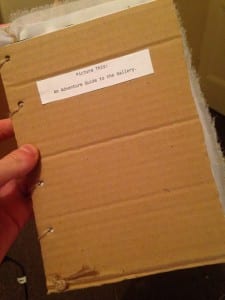
Framing Statement
In this misguide adventure book, we are interested in making the audience or reader the lead role in a narrative that lets them interact and understand the work in new ways. We invite you to engage with the work, providing texture and tasks alongside facts and fiction. You get to engage with the tasks and follow your own route through the Usher. Practitioners and artists that we have taken inspiration from are Wrights and Sites; the use of work from A Sardine Street Box of Tricks and taking inspiration from Grayson Perry. Our thematic concern was to emulate a conceptual collage of ideas, routes, stories and experiences that are not usually part of the gallery experience. ‘We’re all alive, but we don’t know why or what for; we’re all searching for happiness; we’re all leading lives that are different and yet the same.’ (Anne Frank, 2002, 324) Using the narratives of peoples lives with struggles and emotional story-lines; it highlights that the human race is all the same in the most basic aspects of life. This relates back to the artwork as the narratives are imagined and expanded from what can be physically seen in the artwork; this is a new way of experiencing the artwork in the gallery.
Marketing Text
Imagine an adventure guide to the Usher Gallery that places you, the reader, as the lead in your own narrative. Using the works in the gallery you are guided from one picture to another developing the story and interacting with the art in new ways. Picture This: An Adventure Guide to the Gallery is a handmade book that asks you to interact with the work through six different developing stories. A sensory experience that allows the reader, the opportunity to become invested in their own outcome; providing choices and tasks to immerse them in the written work and the art itself.
Pearson: Theatre and Archaeology
Theatre/Archaeology by Pearson and Shanks has enlightened me to new ways we can perceive artefacts. When examining an artefact there are the stages of ‘categorisation and classification, analysis and narrative.’ (Pearson and Shanks, 2001). Which allow us to narrow down the way they can be interpreted and enable us to give meaning. Heterogeneity indicates the diversity for example in a natural environment there is a variety of different species making it heterogeneous due to the variation. This is significant and relevant to a museum placement, as it will contain varieties of art and artefacts from varying time periods. Moreover this can be applicable to us as actors as ‘Social actors are as much artefacts as other material cultural term’ (Pearson and Shanks, 2001) but in a way, this can be implemented into society and careers that take on certain roles. Performance and archaeology that are based and represented on previous memories create memories themselves as it gives a more contemporary portrayal, this will continue to happen throughout time, this is a reason for preserving an extensive account of history in order to keep reinterpreting further.
First Task
Within the Usher Gallery and The Collection different parts of the walls present different time periods and therefore this can used to personify the suggestion if walls could talk. By using different individuals for each time period or two people to contrast the difference between the average woman and man of that time period. This will be done within the Architecture gallery and will highlight the experiences and lives of each significant time period for example Stone Age, Bronze Age, Iron Age etc. A spotlight could be used to highlight each individual representing that persona and metaphorically displaying the time periods, which are displayed on the walls. The people would build a character, which would have represented how the society functioned and this would contrast throughout all the monologues and duologues. This would give a modern interpretation of each time period allowing it to connect with other demographics, which otherwise would not have been as relatable with only the gallery itself.
A Starting Point: Practitioner’s Work
We remain Fascinated with how technology creates new cultural spaces’ (Blast Theory (1), 2015) Blast Theory’s early work began as live art but as time and technology has expanded this has become less apparent – Or has it become twenty first century live art?
Invisible Bullets (1997)
This performance was a re-enactment of a murder scene, which lasted 12 hours. The performance was repeated the same scene in several different ways for example one with balaclava’s and one where the performers were in their underwear others were done seriously or parodied. The performance was done in Nottingham and Germany; the building in Nottingham was created specifically for the performance. This related to a past murder scene but as it was undetermined, which re-enactment was the correct way as there was so many past alternatives. The space used was a large and open area and used to be a pedestrian (walk in). The audience and spectators were directly in sight of the performances. The performance was documented through video and was promoted through a video in the style of an artist’s music video. Moreover the access of the performance was performed in both Nottingham and Germany.
This performance may not have been relevant to our final performance however it served as a great example of site specific performance.
This performance was a phone call which was inspired from ‘a million objects gives rise to a million thoughts’ (Blast Theory (2), 2015) I believe this implies artefacts/art inspire everyone and there are millions of different aspects of the same thing. The audience listens to a recording giving instructions and describing what you can see. It gives stimuluses’ allowing the audience to create their own performance. It suggest where you may go within the building and makes you question who, what, where, why and how. The technology of today makes you question how thing worked in the past moreover makes the distinction of what is the past and what is now (The Present). The audience ultimately are the performance – They choose the path they take. This was documented through the recording and videos.
This is relevant to the type of site specific performance we did but instead of using audio as a misguide, we used the performance in the format of an adventure book. It brought new feelings and experiences with artefacts and artwork; this is precisely our objective with our performance.
A Task For Your Audience: Consider an Art Piece Critically
My task was for a single participant to find a piece of artwork they liked and answer the following questions based on sex life and sexuality of the artist.
1.) What is the sexual orientation of the artist?
2.) Has the artist been involved in abusive or controlling relationships?
3.) What was their sexuality and sex life like?
4.) Were they happy in their relationship status?
5.) Has any of this effected the piece of art?
These questions were to identify whether the sexual aspects of the artist’s life affected the art in any way. Moreover the topic choice was due to a genuine interest into how a passion for gender and sexuality can influence art.
The participant answers to the questions using the …
- Straight, it would appear
- The woman in the painting looks like she could be controlling, so maybe
- Quite Passionate
- The absence of the man could mean unfulfillment
- It’s made me think more about the woman
These questions on this art piece in particular worked well as there were some obvious implications of sexuality and relationships and therefore it allowed me to see the participant to critically analyse this art piece. This task was useful for the development of my final piece, as it engages the audience and an art piece by using a task to show imagination and their perception on a particular artwork. Similarly to our performance where we formed tasks, this allowed us to receive a response from the audience and it also forms documentation of the performance. This was especially helpful in the formation and development the sexuality narrative.
Pearson’s Why Performance
Following the reading on Why Performance by Mike Pearson, it has been understood that the following reasons why performance can be used as a method for examining and analysing a particular landscape. The landscape is researched and utilised for artistic engagement as a site specific performance.
He made the following reasons clear why performance can be used in this way:
1) Enhancing and informing public appreciation
2) Stimulating public imagination
3) Performance can bring to life the history and culture of a landscape
4) Reacting ‘onto’ (fiction) and ‘from’ (documentary)
5) Provide a mechanism for enacting the intimate connection between personal biographies, social identities and biography of place
6) To provoke questions about a place
7) Shifting from the ‘optic to the haptic’
8) Illuminate places that do not easily reveal themselves but which have their own unique characteristics, qualities and attractions.
9) Combines creativity and academia
As enlightening as all these point are I will use my top three to find a relevant connection to my process of my own site specific performance. The first was number five; this is relevant because when using narratives within art pieces it is important to make an intimate connection. An intimate connection allows our audience or participant to relate the stimulus to their own lives and this will essentially allow them to engage and make the performance their own. Moreover ‘shift from the optic to haptic’ (Pearson, 2011) optic meaning vision and haptic meaning touch, this is simply depicting the process of where the audience or participant perception change from just seeing to experiencing, embodying an emotional connection with the site. This is relevant as it important that people make a connection with my performance otherwise the audience will not actively engage, they will simply become a passive viewer making their experience meaningless. Lastly number eight, highlighting places which one would have not been so easily considered allows us to push site specific performances in new directions for learning. This is relevant to my process, as I should always be thinking of new ways to push forward my own performance to make sure it develops to the furthest possible.
The Adventure Book
Finally we came to the idea of utilising the art by interweaving narratives into a journey book. Firstly we formed our first narrative from eight art pieces. At the start there is a choice between two different contrasting story lines that the audience can choose to take as their journey. This allows the audience to make their own decisions or pathway and therefore this allows more variation in experience. Our work requires the audience’s perception and reactions to form the performance and by connecting to them emotionally we are allowing the performance to relate to them on a personal level. Drafting our first narrative we have realised that to strike more of an interest it is important to make the narrative more intriguing, bold and controversial. For example the love narrative began with a story line that was too conventional and therefore more depth was needed. Moreover the directions were required to be more specific and we added in a map with coordinates using letter and numbers to identify what room and what side of the wall the artwork was in. Incorporating more options and interweaving the other narratives together will help to develop the narratives individually as well as a whole piece.
Our Influences
A Sardine Street Box of Tricks was our main inspiration as it is all about way of performing by using a mis-guide. As mis-guide tour guides we worked together instead of competition. Moreover instead of using a guide to tour the audience, we used directions in the book as a main guide of route; this allowing the audience to choose their own specific and individual pathway. We used one person as introduction and explanation of how to use the book and the other two as help and guidance with journey and tasks, which were included throughout certain routes. ‘Be sure to find a space on your own tour for some shameless reminiscence, personal or quirky association, dream or hallucination.’ (Crab Man and Signpost, 2011, 42). This gave our narrative and stories reasons and made it more spellbinding for the audience. ‘a white plastic bag and moulding each of them, through an action, into an idea’ (Crab Man and Signpost, 2011, 45). This refers to our work as we used something simplistic such as an ambiguous art piece and forming a world of imagination around it.
Grayson Perry’s artwork helped form more controversial and significant narratives. The piece named ‘untitled’ leaves the audience to make their own decision and opinion on the photograph. As well as this, it allowed us to form an interesting route for two alternate narratives. “I just love dressing up in everything a man is supposed not to be, in all that vulnerability, sweetness, preciousness and impracticality.” (Jefferies, 2003) This quote was an interesting starting point to expand on with his art pieces and helped us to form the other narratives as well. We explored both biological male and female gender identity struggles; this meant that anyone gender could engage and you could also choose, which gender you wanted to be. It also questions and provokes the meaning of gender in society.
Wrights and Sites was another influence. The walking to and from artwork physically represented the journey each person took from our performance ‘Today, walking and exploring the everyday remains at the heart of all we do, and what we make seeks to facilitate walker-artists, walker-makers and everyday pedestrians to become partners in ascribing significance to place.’ (Mis-Guide, 2012) Using the act of walking relates to peoples lives and their journeys that they conquer on an everyday basis. Moreover it gives the audience a way to actively engage on the journey, walking from artwork to artwork.
Our Development
‘story-telling is indicative of a recent development in socially engaged site-specific art’ (Till, 2008, 102) using our book we’re engaging the audience by using stories and or narratives, which activates ones social memory for example the audience will engage emotionally by relating it their own lives and experiences.
I was responsible for the sexuality narrative; I wrote a storyline that involved sexual assault, gender dysphoria and transvestism/transsexuality. I used to separate story-lines; I gave the audience a choice whether to take the journey of a female or a male struggling with gender identity. I used factual diagnosis of gender dysphoria and definition of transgender, this allows the audience to understand the difference between the two terms and engage with the story. I utilised one of the long case clocks, which had an Adam and Eve image above the dial, so I decided to incorporate religion into the narrative to depict a social stigma about how gender dysphoria could be seen as sinful. This exploration of controversial topics pushes the audience to have more engagement rather than passively looking at the artwork. I added a task at the end of this narrative; this was to give the audience an opportunity to actively participate in the story and allows us to see their thoughts and ideas that have been developed through the journey. The sexual assault section was described in quite an explicit and crude way and therefore I added in a trigger stating ‘sexual assault’, this ensured anyone who dislikes or would rather avoid reading about this topic could easily avoid it. Moreover I created an alternate route with a censored version, which could still engage the audience that would rather avoid reading about such graphic writing. I have used this story to make the audience question how gender works in society and how different forms of sexuality are accepted.
We did not rehearse our performance, as the audience created the performance. Our rehearsal was essentially the development and formation of the book, so instead we checked the writing and directions were efficient enough to work for the public. Alterations were made slightly as mistakes and minor cause for concerns arose within our tech run of the performance. By using the public to test run our performance before the day, it allowed us to see what would work well and what did not and how to alter any mistakes so the performance would run smoother.
Documentation
The tasks provided documentation of our participant’s journeys. This varied with postcards to Grayson Perry, naming the dog tags, the ballot box as well as drawings.
Here are some photos from our performance when the book was being used.
This page was typewritten, making it feel more personal and also connected with the words and the art piece it is referring to.
Whether the condom was taken or not was documentation to see whether the audience would want a free condom after the experience.
The lips were something very personal and simple, a way of leaving their mark behind.
This made the reading experience different with each word being stuck in individually.
Evaluation
The day of the performance our role was to be inviting, to help and guide when necessary and provide tasks for some of the story-lines. Out of the people that entered the gallery during our availability of the books, only half of the people wanted to engage with the book however the ones who did, explored the different narratives with excitement and fascination. Re-creating the art into themed pages gave the audience a starting point or a trigger to bring out the emotions from the narratives further. The costume for our performance art was elegant and inviting for an organised and formal guidance for the misguide. Costume was debated for quite a while; one of our ideas was to use characters from the narratives to re-create them in real life. However we decided against this idea, as we wanted to keep it sophisticated and keep the performances origination from only the book.
We received positive feedback about the stylised way of portraying our adventure book; therefore our appearance and presentation drew the audience in and kept their attention onto the book. Moreover we received positivity about the emotional and developing narratives as well as the playful format of the adventure book. Some people found they experienced the art in new ways that made them want to explore the gallery even more. Next time a way to improve was to make the art works location more specific and clear and also perhaps to use a small picture of the artwork on each page, so one can identify the art work more easily. An alternative way of presenting our performance could have been the process of making the books in the gallery and then giving the book once completed to a person from the audience (that has watched us make it) to use it and make their own performance from there. Lastly we could have found a way of documenting each person’s specific route by using coloured twine that would correspond to which narrative one followed. Working with Site Specific theory and practice has changed my perception and knowledge of what is performance and where it can take place. It has made me realise that anything that a performance can create itself from within a site.
Works Cited/ Bibliography
Anne Frank (2002) The Diary of a Young Girl. London: Penguin Books.
Blast Theory (1) (2015) Our History & Approach. [online] England: Blast Theory Available from http://www.blasttheory.co.uk/our-history-approach/[Accessed 14 February 2015].
Blast Theory (2) (2015) Ghostwriter. [online] England: Blast Theory Available from http://www.blasttheory.co.uk/projects/ghostwriter/ [Accessed 14 February 2015].
Crab Man and Signpost (2011) A Sardine Street Box of Tricks. Blurb.Pearson, M. (2011) Why Performance. Arts & Humanities Research Council.
Jefferies, S. (2003) Top of the Pots. [online] The Guardian. Available from http://www.theguardian.com/artanddesign/2003/nov/21/art.turnerprize2003 [Accessed 11 May 2015].
Mis-Guide (2012) Wrights & Sites: About. [online]Mis-Guide. Available from http://www.mis-guide.com/ws/about.html [Accessed 12 May 2015].
Pearson, M. and Shanks, M. (2001) Theatre/ Archaeology. London: Routledge.
Pearson, M. (2011) Why Performance. Arts & Humanities Research Council.
Till, E, K (2008) Memory Studies: Artistic and Activist Memory-Work: Approaching Place-Based Practice. University of Northampton: Sage Publications.
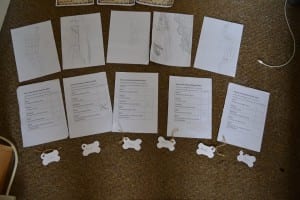
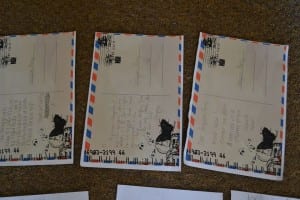
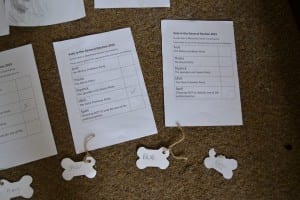
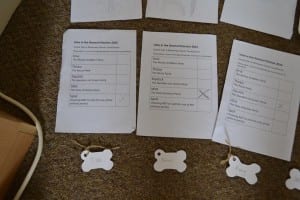
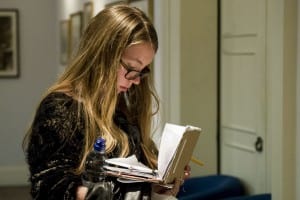
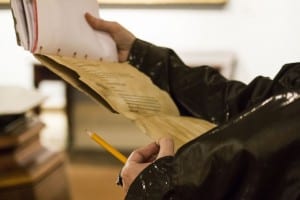
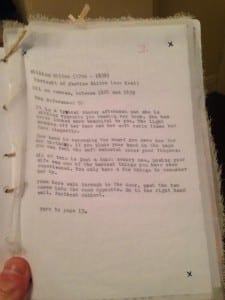
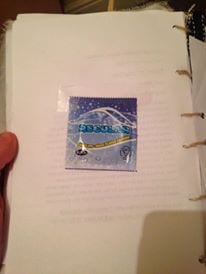
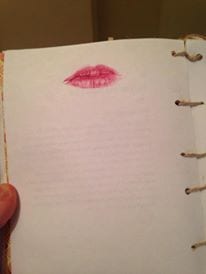
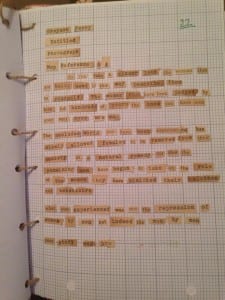
Recent Comments